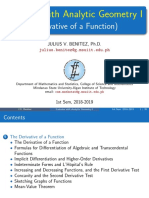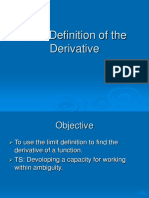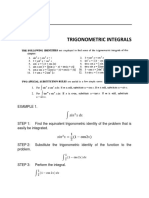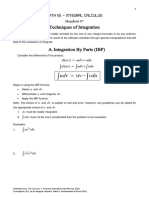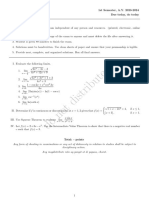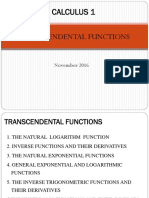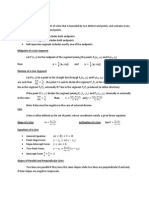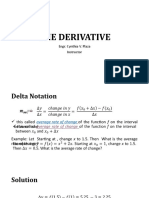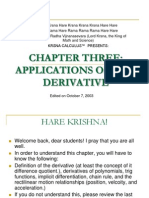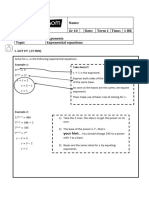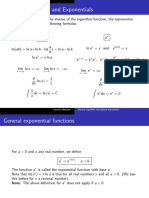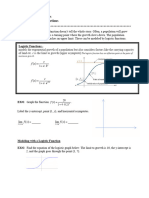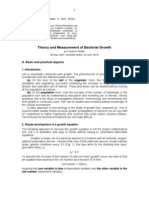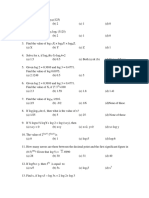Integral Calculus 1
Integrals Yielding Logarithmic Functions and Integration of
Exponential Functions
Integrals Yielding Logarithmic Functions and
Integration of Exponential Functions
This module covers the integrals yielding logarithmic functions and
exponential functions.
Course Module Objectives:
At the end of this module, the learner should be able to:
1. Identify u, and du
2. Memorize the basic integration formulas for exponential functions
and integrals yielding logarithmic functions
3. Apply the appropriate formula
4. Evaluate the integrals
Integrals Yielding Logarithmic Functions
The integral of any quotient whose numerator is the derivative of the
denominator is the logarithm of the denominator.
𝑑𝑢
∫ = ln 𝑢 + 𝑐 ; 𝑢 > 0
𝑢
Illustrative Examples:
𝟏
Example 1: ∫ 𝟓𝒙−𝟐 𝒅𝒙
Solution: 𝐿𝑒𝑡: 𝑢 = 5𝑥 − 2, 𝑑𝑢 = 5 𝑑𝑥
1
𝐶𝐹 = 5
Transforming the integrand
1 1 1
= ∫ 𝑑𝑢 = ln|𝑢| + 𝐶
5 𝑢 5
1
Answer: = 5 ln|5𝑥 − 2| + 𝐶
𝑥3
Example 2: ∫ 𝑥4 − 5 𝑑𝑥
Solution: 𝐿𝑒𝑡: 𝑢 = 𝑥 4 − 5, 𝑑𝑢 = 4𝑥 3 𝑑𝑥
1
𝐶𝐹 =
4
Transforming the integrand
� Integral Calculus 2
Integrals Yielding Logarithmic Functions and Integration of
Exponential Functions
1 1 1
= ∫ 𝑢 𝑑𝑢 = ln|𝑢| + 𝐶
4 4
1
Answer: = ln|𝑥 4 − 5| + 𝐶
4
Example 3: ∫ cot 𝑥 𝑑𝑥
cos 𝑥
Solution: Recall that 𝑐𝑜𝑡 𝑥 = sin 𝑥
𝐿𝑒𝑡: 𝑢 = sin 𝑥, 𝑑𝑢 = cos 𝑥 𝑑𝑥
cos 𝑥 1
=∫ 𝑑𝑥 = ∫ 𝑑𝑢 = ln|𝑢| + 𝐶
sin 𝑥 𝑢
Answer: = ln|sin 𝑥| + 𝐶
4
Example 4: ∫ 𝑥 ln 𝑥 𝑑𝑥
4 𝑑𝑥
Solution: The integrand can be arranged into ∫ ln 𝑥 𝑥
1
𝐿𝑒𝑡 𝑢 = ln 𝑥, 𝑑𝑢 = 𝑑𝑥
𝑥
1
= 4 ∫ 𝑢 𝑑𝑢 = 4 ln|𝑢| + 𝐶
Answer: = 4 ln(|ln 𝑥|) + 𝐶
cos 2x
Example 5: ∫ 1−sin 2x dx
Solution: Recall that the derivative of sin u = cos u. cos u is in the
numerator and sin u is in the denominator.
𝐿𝑒𝑡: 𝑢 = 1 − sin 2𝑥, 𝑑𝑢 = −2 cos 2𝑥 𝑑𝑥
−1
𝐶𝐹 = 2
1 1 1
= − ∫ 𝑑𝑢 = − ln|𝑢| + 𝐶
2 𝑢 2
Answer:
1
= − ln|1 − sin 2𝑥| + 𝐶
2
3𝑥 5 + 2𝑥 2 −3
Example 6: ∫ 𝑑𝑥
𝑥3
Solution: Take note that the degree of the numerator is higher than that
of the denominator. The approach then is to divide each of the terms of the
numerator by the denominator.
Remember to divide the numerator by the denominator if the degree of the
numerator is equal to or greater than the degree of the denominator.
� Integral Calculus 3
Integrals Yielding Logarithmic Functions and Integration of
Exponential Functions
Dividing each of the terms of the numerator yields
1
= 3 ∫ 𝑥 2 𝑑𝑥 + 2 ∫ 𝑑𝑥 − 3 ∫ 𝑥 −3 𝑑𝑥
𝑥
Using power formula on the first and third integrands and letting u = x, and du
= dx; thereby yielding logarithmic function after integration for the second
term.
3
Answer: = 𝑥 3 + +2 ln|𝑥| + 2 𝑥 −2 + 𝐶
1
Example 7: ∫ 𝑑𝑥
√𝑥 (1− √𝑥)
Solution: To identify u and du in the integrand, it is imperative to rearrange
the terms of the denominator. Identify which term can be the u and which can
be the du. ( 1 − √𝑥) cannot be the derivative of √𝑥 so it could be the other way
around.
1
𝐿𝑒𝑡: 𝑢 = 1 − √𝑥 , 𝑑𝑢 = − (2 𝑥 ) 𝑑𝑥
√
𝐶𝐹 = −2
1
= −2 ∫ 𝑑𝑢 = −2 ln|𝑢| + 𝐶
𝑢
Answer: = −2 ln|1 − √𝑥| + 𝐶
𝑥+6
Example 8: ∫ (𝑥+2)2 𝑑𝑥
Solution: The denominator has x + 2. The numerator has x + 6 that can be
broken into (x + 2) + 4 which will simplify the denominator.
𝑥+2 4
=∫ 2
𝑑𝑥 + ∫ 𝑑𝑥
(𝑥 + 2) (𝑥 + 2)2
1
= ∫ 𝑥+2 𝑑𝑥 + 4 ∫(𝑥 + 2)−2 𝑑𝑥
Let u = x + 2; du = dx and let u = x + 2; n = - 2; du = dx.
𝑑𝑢 𝑢𝑛+1
∫ 𝑢 = ln u + c. Likewise, ∫ 𝑢𝑛 𝑑𝑢 = 𝑛+1
Answer: = 𝑙𝑛(𝑥 + 2) − 4(𝑥 + 2)−1 + 𝐶
� Integral Calculus 4
Integrals Yielding Logarithmic Functions and Integration of
Exponential Functions
Integration of Exponential Functions
There are two basic formulas for the integration of exponential functions:
1. ∫ 𝑒 𝑢 𝑑𝑢 = 𝑒 𝑢 + 𝑐
𝑎𝑢
2. ∫ 𝑎𝑢 𝑑𝑢 = ln 𝑎 + 𝑐
Notice that in both formulas u is the exponent.
Illustrative Examples:
Example 1: ∫ 2𝑒 3𝑥 𝑑𝑥
1
Solution: let u = 3x; du = 3dx; CF = 3
1
= 3 ∫ 2𝑒 3𝑥 ∙ 3 𝑑𝑥
𝟐
Answer: = 𝒆𝟐𝒙 + 𝑪
𝟑
Example 2: ∫ 𝑒 2−5𝑥 𝑑𝑥
−1
Solution: Let u = 2 – 5x; du = - 5dx; CF = 5
1 2−5𝑥
= −5∫𝑒 ∙ (−5 𝑑𝑥)
−1 −1
= ∫ 𝑒 𝑢 𝑑𝑢 = 𝑒𝑢 + 𝑐
5 5
𝟏
Answer: = − 𝟓 𝒆𝟐−𝟓𝒙 + 𝑪
Example 3: ∫ 𝑒 3𝑥 ∙ 𝑒 2𝑥 𝑑𝑥
Solution: From the laws on exponents, xa + xb = xa+b
= ∫ 𝑒 3𝑥+2𝑥 𝑑𝑥
𝟏 𝟏
Answer: = ∫ 𝒆𝟓𝒙 𝒅𝒙 = 𝒆𝟓𝒙 + 𝑪
𝟓 𝟓
3+𝑒 2𝑥
Example 4: ∫ 𝑒 𝑥 𝑑𝑥
Solution: Distributing the denominator to the terms in the numerator will
yield
3 𝑒 2𝑥
= ∫ (𝑒 𝑥 + 𝑒𝑥
) 𝑑𝑥
Simplifying further,
= ∫(3𝑒 −𝑥 + 𝑒 𝑥 ) 𝑑𝑥
= −3𝑒 −𝑥 + 𝑒 𝑥 + 𝐶
� Integral Calculus 5
Integrals Yielding Logarithmic Functions and Integration of
Exponential Functions
𝟑
Answer: = 𝒆𝒙 − 𝒆𝒙 + 𝑪
3𝑑𝑥
Example 5: ∫ 4+𝑒 𝑥
Solution: If ex appears in the denominator only, create another
e in the numerator. The derivative of eu is eudu. Multiplying the integrand
x
with e-x will create similar exponents in both numerator and denominator.
3𝑑𝑥 𝑒 −𝑥
=∫ ∙
4 + 𝑒 𝑥 𝑒 −𝑥
−3𝑒 −𝑥
= ∫ −𝑥 𝑑𝑥
4𝑒 + 1
1
𝑙𝑒𝑡 𝑢 = 4𝑒 −𝑥 + 1; du = −4𝑒 −𝑥 𝑑𝑥; CF = -4
−3𝑒 −𝑥 𝑑𝑥 1 3
= ∫ −𝑥 = − ∫ −𝑥 ∙ (−4𝑒 −𝑥 𝑑𝑥)
4𝑒 + 1 4 4𝑒 + 1
𝟑
Answer: = − 𝟒 𝒍𝒏|𝟒𝒆−𝒙 + 𝟏| + 𝑪
𝑒 2𝑥
Example 6: ∫ 𝑒 𝑥 +6 𝑑𝑥
Solution: The exponent in the numerator can be simplified by dividing
the term in the numerator by the terms in the denominator.
36
= ∫(𝑒 𝑥 − 6 + 𝑥 ) 𝑑𝑥
𝑒 +6
𝑑𝑥
= ∫ 𝑒 𝑥 𝑑𝑥 − 6 ∫ 𝑑𝑥 + 36 ∫ 𝑥
𝑒 +6
𝑥
𝑑𝑥 𝑒 −𝑥
= ∫ 𝑒 𝑑𝑥 − 6 ∫ 𝑑𝑥 + 36 ∫ 𝑥 ( )
𝑒 + 6 𝑒 −𝑥
−𝑥
𝑒 𝑑𝑥
= ∫ 𝑒 𝑥 𝑑𝑥 − 6 ∫ 𝑑𝑥 + 36 ∫
1 + 6𝑒 −𝑥
Let u = 1 + 6𝑒 ; du = −6𝑒 𝑑𝑥
−𝑥 −𝑥
𝑥
(−6𝑒 −𝑥 𝑑𝑥)
= ∫ 𝑒 𝑑𝑥 − 6 ∫ 𝑑𝑥 − 6 ∫
1 + 6𝑒 −𝑥
Answer: = 𝒆𝒙 − 𝟑𝒙 − 𝟔𝒍𝒏|𝟏 + 𝟔𝒆−𝒙 | + 𝑪
Example 7: ∫ 53𝑥 𝑒 3𝑥 𝑑𝑥
Solution:
= ∫(5𝑒)3𝑥 𝑑𝑥
𝑎𝑢
= ∫ 𝑎𝑢 𝑑𝑢 =
ln 𝑎
� Integral Calculus 6
Integrals Yielding Logarithmic Functions and Integration of
Exponential Functions
1 (5𝑒)3𝑥
= ∙ +𝐶
3 ln(5𝑒)
𝟏
Answer: = 𝟑 𝐥𝐧(𝟓𝒆) ∙ (𝟓𝒆)𝟑𝒙 + 𝑪
Example 8: ∫ 34𝑥 𝑑𝑥
Solution:
1
= ∫ 34𝑥 ∙ 4 𝑑𝑥
4
1 34𝑥
= ∙ +𝐶
4 𝑙𝑛3
𝟏
Answer: = (𝟑𝟒𝒙 ) + 𝑪
𝒍𝒏𝟑𝟒𝒙



